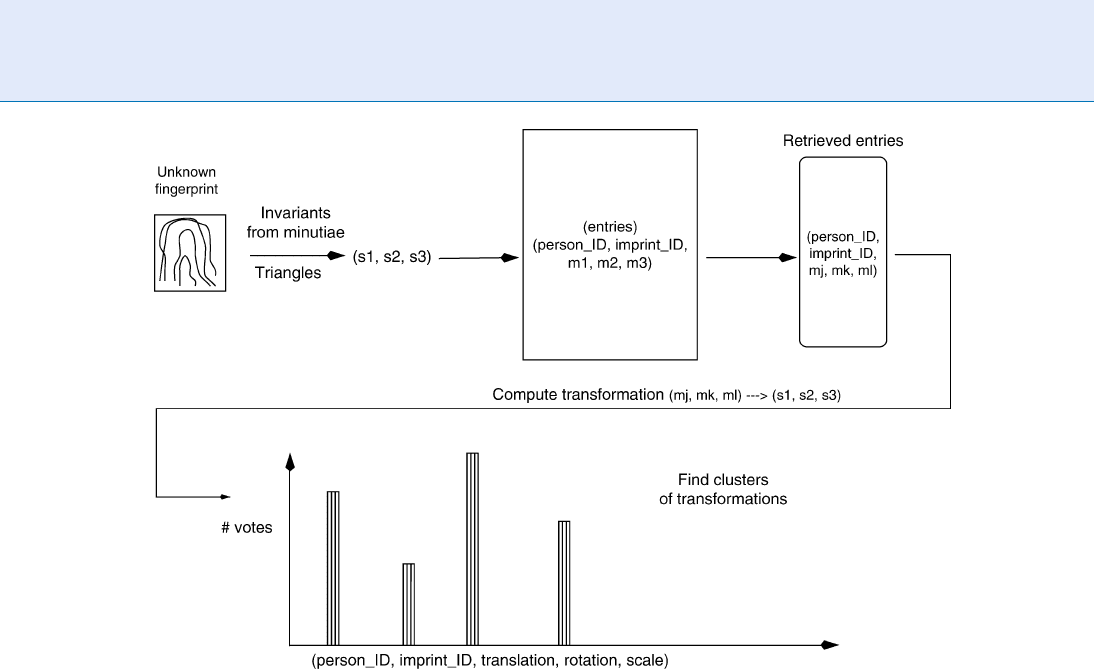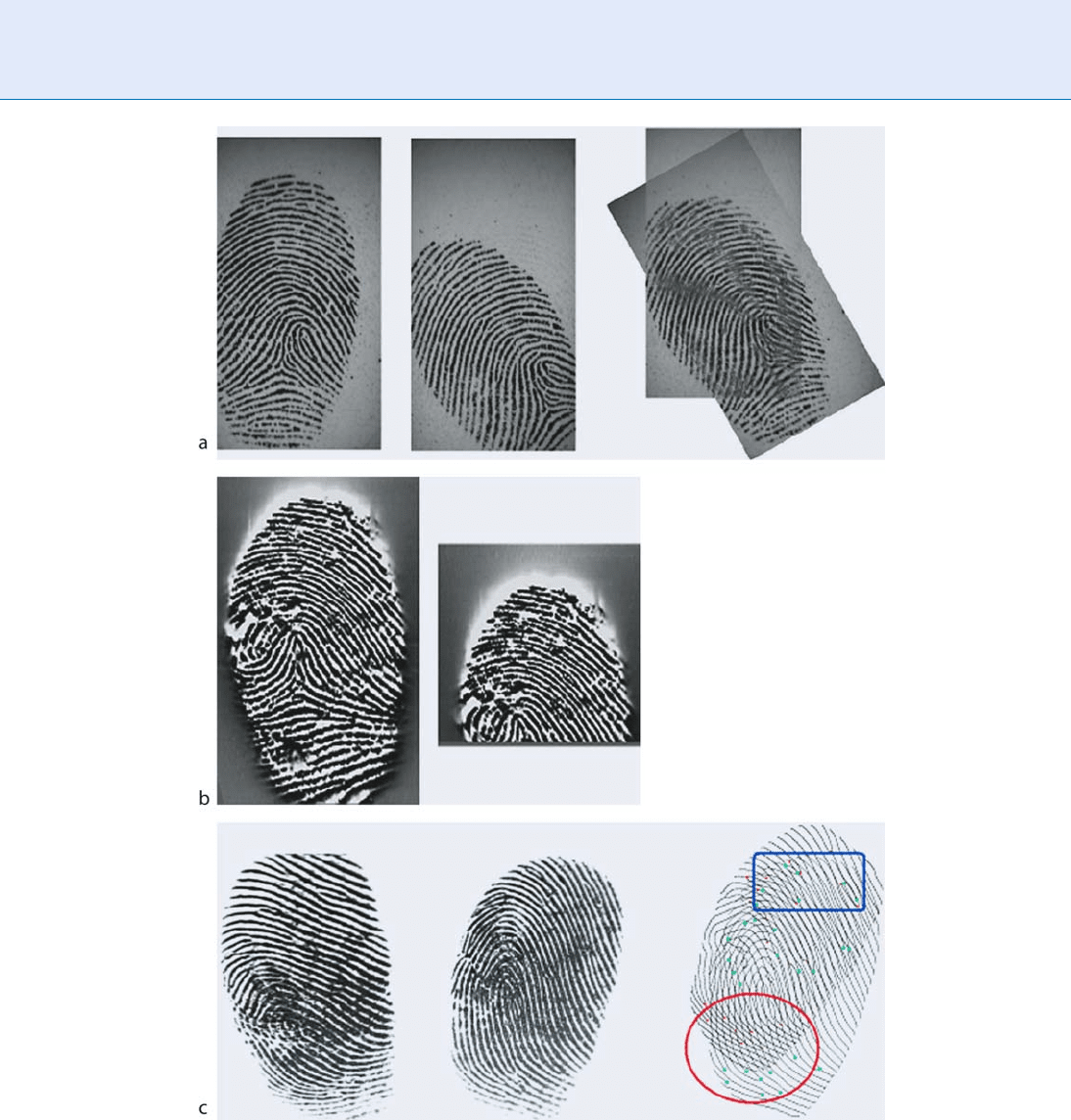Li S.Z., Jain A.K. (eds.) Encyclopedia of Biometrics
Подождите немного. Документ загружается.


a newly acquired sample should replace the en-
rolled one. An alternative would be to retain
both the old and new samples for use in a
multi-instance fusion scheme.
e. Template Update
Again to address template aging, some systems
instead combine old and new sample features.
Quality could be used in this process.
Summary
Fingerprint quality measurement is an operationally
important task. This pap er enumerated ways in
which it is useful to compute a quality value from a
sample. In all cases the ultimate intention is to improve
matching performance. The authors asserted therefore
that quality algorithms should be developed to explic-
itly target matching error rates, and not human per-
ceptions of sample quality. The term quality should
not be equated to the acquisition settings of the sam-
ple, such as image resolution, dimensions in pixels,
grayscale/color bit depth, or number of features.
Though such factors may affect sample utility and
could contribute to the overall quality score. We
reviewed the existing practice of fingerprint local and
global analysis. Local and global quality scores could be
combined to form a vector of overall finger image
quality. However, it is useful, even necessary for some
applications, if local and global quality measures are
summarized into a scalar which is predictive of error
rates associated with the verification or identification
of that sample.
Related Entries
▶ Biometric Sample Quality Standard
▶ Performance of Quality Measures
References
1. Maltoni, D., Maio, D., Jain, A.K., Prabhakar, S.: Handbook of
Fingerprint Recognition. Springer, New York (2003)
2. Grother, P., et al.: MINEX: Performance and Interoperability of
the INCITS 378 Fingerprint Template. National Institute of
Standards and Technology, NISTIR 7296 edn. (2005). http://
fingerprint.nist.gov/minex04
3. Tabassi, E., Wilson, C., Watson, C.: Fingerprint Image Quality,
NFIQ. National Institute of Standards and Technology, NISTIR
7151 edn. (2004)
4. Tabassi, E., Wilson, C.L.: A novel approach to fingerprint image
quality. In: ICIP (2), pp. 37–40 (2005)
5. Tilton, C., et al.: The BioAPI Specification. American National
Standards Institute, Inc. (2002)
6. Benini, D., et al.: ISO/IEC 29794-1 Biometric Sample Quality
Standard: Framework. JTC1 / SC37 / Working Group 3 (2008).
http://isotc.iso.org/isotcportal
7. Alonso-Fernandez, F., Fierrez, J., Ortega-Garcia, J., Gonzalez-
Rodriguez, J., Fronthaler, H., Kollreider, K., Bigun, J.: A Com-
parative study of fingerprint image-quality estimation methods.
IEEE Trans. Inform. Forens. Secur. 2, 734–743 (2007)
8. Lim, E., Jiang, X., Yau, W.: Fingerprint image quality and validity
analysis. In: IEEE proceedings of International Conference on
Image Processing (ICIP), pp. 469–472. New York, USA (2002)
9. Chen, Y., Dass, S.C., Jain, A.K.: Fingerprint quality indices for
predicting authentication performance. In: AVBPA, pp. 160–170
(2005)
10. Shen, L., Kot, A.C., Koo, W.M.: Quality measures of fingerprint
images. In: AVBPA, pp. 266–271 (2001)
11. Ratha, N., Bolle, R.: Automatic Fingerprint Recognition Sys-
tems. Springer, New York (2004)
12. Lim, E., Toh, K.A., Saganthan, P.N., Jiang, X., Yau, W.Y.: Finger-
print image quality analysis. In: ICIP, pp. 1241–1244 (2004)
13. Chen, T.P., Jiang, X., Yau, W.Y.: Fingerprint image quality analy-
sis. In: ICIP, pp. 1253–1256 (2004)
14. Bolle, R., et al.: System and methods for determining the quality
of fingerprint images. US Patent 596356 (1999)
15. Hong, L., Wan, Y., Jain, A.K.: Fingerprint image enhancement:
algorithm and performance evaluation. IEEE Trans. Pattern
Analy. Mach. Intell. 20(8), 777–789 (1998)
16. Nill, N., Bouzas, B.H.: Objective image quality measure derived
from digital image power spectra. Opt. Eng. 31(4), 813–825
(1992)
17. National Institute of Standards and Technology: NIST Biometric
Image Software (NBIS) (2008). http://www.itl.nist.gov/iad/
894.03/nigos/nbis.html
18. Ko, T., Krishnan, R.: Monitoring and reporting of fingerprint
image quality and match accuracy for a large user application.
In: Proceedings of the 33rd Applied Image Pattern Recognition
Workshop, pp. 159–164. IEEE Computer Society (2004)
19. Tabassi, E., Grother, P.: Quality Summarization: Recommendations
on Enterprise-wide Biometric Quality S ummarization. N ational
Institute of Standards and Technology, NISTIR 7244 edn. (2007)
20. Wein, L.M., Baveja, M.: Using fingerprint image quality to
improve the identification performance of the u.s. visit program.
In: Proceedings of the National Academy of sciences (2005).
www.pnas.org/cgi/doi/10.1073/pnas.0407496102
21. Fierrez-Aguilar, J., Ortega-Garcia, J., Gonzalez-Rodriguez, J.,
Bigun, J.: Discriminative multimodal biometric authentication
based on quality measures. Pattern Recogn. 38(5), 777–779 (2005)
22. Tabassi, E., Quinn, G.W., Grother, P.: When to fuse two
biometrics. In: IEEE Computer Society Conference on Com-
puter Vision and Pattern Recognition CVPR-06. New York
(2006). Biometric Workshop
490
F
Fingerprint Image Quality

Fingerprint Indexing
GEO RGE BEBIS
University of Nevada, Reno, NV, USA
Synonyms
Continuous classification; Fingerprint retrieval; finger-
print authentication; fingerprint identification
Definition
When matching a query fingerprint to a large finger-
print database for identification purposes, a critical
issue is how to narrow down the search space. Indexing
provides a mechanism to quickly determine if a query
fingerprint is in the database and to retrieve those
fingerprints that are most similar with the query, with-
out searching the whole database.
Introduction
Fingerprint matching is one of the most popular and
reliable biometric techniques used in automatic personal
identification. Typically, fingerprint matching is based
on low-level features determined by singularities in
the finger ridge pattern known as minutiae.Tobe
practical, matching should be robust to translation,
rotation, scale, shear, occlusion, and clutter. In this con-
text, matching two fingerprints implies finding a subset
of minutiae in the first fingerprint that best match to a
subset of minutiae in the second fingerprint through
a geometric transformation in an optimal sense.
There are two main applications involving finger-
print matching: fingerprint authentication and fin-
gerprint identification. While the goal of fingerprint
authentication is to verify the identity of a person,
the goal of fingerprint identification is to establish
the identity of a person. In this case, matching involves
comparing a query finge rprint against a database of
reference fingerprints to establish the identity of the
query. An important issue in fingerprint identification
is how to select the most similar fingerprint(s) to the
query fingerprint from the fingerprint database. The
easiest but least effective way to search a large database
is to compare the query fingerprint with each
fingerprint in the database. Since usually there is no
a-priori knowledge of possible correspondences be-
tween the query and the reference fingerprints, howev-
er, matching can be computationally too expensive,
even for a moderate number of reference fingerprints.
A common approach to narrow down the search is
by dividing the fingerprint database into smaller sets
using fingerprint classification. The idea is to match the
query fingerprint against fingerprints of the same ty pe
only. Although this approach can reduce the number
of matches, it is not ver y effective since fingerprints are
unevenly distributed (i.e., more than 90% of the fin-
gerprints belong to only three classes [1]). Several sub-
classification systems have been proposed to address
this issue by further dividing some of the classes into
more specific categories, however, these systems are
much more complex and difficult to implement [1].
A more effective approach to narrow down the
search space is to use indexing. In principle, indexing
can quickly determine if a query fingerprint is in the
database and to retrieve those reference fingerprints
which are most similar to the query fing erprint, with-
out searching the whole database. Therefore, methods
based on indexing are less dependent on the size of
the database. The main idea is to assign an index value
to each fingerprint and match the query against those
reference fingerprints having comparable indices only.
Indexing methods have been very popular in computer
vision for searching large databases of models in
object recognition [2–4]. Therefore, many indexing
schemes for finger identification have their roots in
object recognition.
How Indexing Works
Indexing is a mechanism which, when provided with a
key value, can rapidly access some associated data.
Thus, instead of searching the space of all possible
matches and explicitly rejecting invalid ones, indexing
inverts the process so that only the most feasible
matches are considered for matching. In essence,
indexing serves as a ‘‘filtering’’ step which allows to
verify a query fingerprint agai nst the most similar
fingerprints in the database only. To implement
indexing, certain information about the reference fin-
gerprints is prestored in an index structure. During
identification, the index structure is accessed efficiently
to narrow dow n the search.
Fingerprint Indexing
F
491
F

Typically, a single index can be computed from the
whole fingerprint or multiple indices can be computed
from groups of local features. Using a single index,
fingerprints are mapped to numerical vectors in a high-
dimensional space through a similarity-preserving
transformation. During identification, the query
fingerprint is compared against those reference finger-
prints which are close to the query in the multidimen-
sional space. This approach, also known as continuous
classification [5 ], is in essence a classification approach,
however, the classes are not disjoint. Commonly, the
orientation image is used in the mapping transforma-
tion, however, different transformations and distance
measures have been proposed [5–8].
Using groups of local features, reference finger-
prints are represented redundantly in the database
by computing a separate index for each group of
features and making an entry for each index [9–11].
This kind of redundancy provides robus tness during
identification by allowing the retrieval of reference
fingerprints that match the query fingerprint only
partially. Specifically, for each reference fingerprint,
groups of features are extracted and an index is
constructed from each group. The indexed locati-
ons are filled with entries containing information
about the reference fingerprints. At a minimum, each
entry contains information about the identity of the
reference fingerprint and the group of features that
generated the index.
During identification, the information stored in the
index structure is used to quickly eliminate noncompat-
ible matches between the query and the reference fin-
gerprints. To reduce the number of false matches,
geometric constraints can be used [11]. The reference
fingerprints listed in the indexed locations are collected
into a list of candidate fingerprints and the most
often indexed fingerprints are selected for further veri-
fication. Verification works by computing the transfor-
mation between the candidate fingerprints and the
query. Then, the candidate fingerprints are aligned
with the query and their similarity to the query is
estimated by finding the percentage of candidate fea-
tures that have been aligned with query features.
An Example
Here is an example, based on [9, 10], to illustrate the
use of indexing for fingerprint identification. In this
example, matching a pair of minutiae sets is performed
by comparing minutiae triangles, formed by minutiae
triplets, using geometric invariant features. In general,
a pair of corresponding minutiae triangles provides
enough information to compute a geometric transfor-
mation (e.g., similarity or affine) that potentially aligns
the minutiae sets. To compute good alignments, voting
can be applied in the transformation space to find
transformations that are supported by many minutiae
triangles [9]. A number of hypothetical transforma-
tions is obtained by considering transformations that
have received a high number of votes. Each hypotheti-
cal transformation is then explicitly verified by count-
ing the number of aligned minutiae.
The indexing mechanism used in this example
is based on geometric hashing [2]. Specifically, given
a triplet of minutiae, three geometric invariants can
be computed by considering the triangle formed by
the minutiae triplet. The geometric invariants are
based on the sides and angles of the minutiae triangle,
as shown in Fig. 1, and remain unchanged under
similarity transformations (i.e., translation, rotation,
and scale). First, the sides of the triangle are sorted to
avoid considering all possible orderings:
l
1
l
2
l
3
Then, we compute the following geometric
invariants:
0
l
1
l
3
1
0
l
2
l
3
1
1 cosðAÞ1
where A is the angle between the smallest two sides.
To compute an integer index, a simple hash function
is applied on the geometric invariants which involves
linear scaling followed by quantization. For each index,
Fingerprint Indexing. Figure 1 A minutiae triangle
defined by a minutiae triplet (A,B,C).
492
F
Fingerprint Indexing

information is stored about the fingerprint and the
minutiae triangle in a hash table. Each entry stored
in the hash table has the following format:
ðperson
ID; print ID; m
1
; m
2
; m
3
Þ
where person_ID corresponds to the identit y of the
person whose fingerprint is considered, print_ID is
an identification code for the particular finge rprint
of that person, and m
i
are the (x,y) coordinates of
the m
i
minutia in the triangle. Figure 2 illustrates the
indexing step.
During identification, each index generated by
the query fingerprint is used to retrieve all reference
fingerprints stored in the hash table under the same
index. For each minutiae triangle, the lengths of the
sides are computed, sorted in ascending order, and
the geometric invariants are computed as before.
Then, the invariants are scaled and quantized in the
same manner. The resulting index is used to extract
all entries from the database stored at the same index
table location. To account for noise, entries stored in
a small neighborhood around the indexed location
could be also retrieved.
Several indexing-based approaches accumulate
evidence about reference fingerprints by casting a
vote for every entry stored in the indexed locations
and by ‘‘histograming’’ the entries to pick the ones
which have received a high number of votes. However,
this approach takes into consideration only the num-
ber of votes received by a particular entry and not
whether these votes are consistent among themselves.
To introduce a measure of coherence, voting in the
transformation space has been proposed [9]. The idea
is simply to consider transformations which form large
clusters in the transformation space.
Each of the entries retrieved from the index
table represents a hypothesized correspondence
between minutiae triplets in the query and a reference
fingerprint. Given this information, the transforma-
tion that best maps the query triplet to the reference
triplet is computed. The computed transformation
parameters are binned and, along with the person_ID
and imprint_ID, form a key that indexes another data
structure used for ev idence accumulation. An eight-
dimensional integer array is used to store the number
of votes in the transformation space (i.e., six dimen-
sions for the parameters of the transformation, one for
the person_ID and one for the imprint_ID).
If a large number of minutiae points can be brought
into correspondence by a transformation, then all the
indices generated by the triangles formed by those min-
utiae points will yield close transformation parameters.
Hence, a larger number of votes for a correct match will
be accumulated. Although there might be a number of
random correspondences between minutiae triplets in
the query fingerprint and some arbitrary reference fin-
gerprints, the likelihood of a number of consistent
transformation parameters being generated by random
correspondences is small, and the verification step will
eliminate most of them. Figure 3 illustrates these iden-
tification procedure based on indexing.
Practical Issues
Several important issues must be considered
while employing indexing for fingerprint identification
including: index construction, index selectivity, storage
requirements, indexing mechanism, performance anal-
ysis, and error analysis. Each of them briefly discussed
in the following section.
Index Construction
As illustrated in the earlier example, each index
is typically constructed from groups of local featu-
res, such as minutiae triplets. In general, index
construction should be based on features that are
robust to fingerprint distortions, occlusion, and noise
[11]. To reduce storage requirements, the computation
of the index is based on geometric invariant features,
Fingerprint Indexing. Figure 2 Pre-storing information
about the reference fingerprints using indexing.
Fingerprint Indexing
F
493
F

that is, features that remain unchanged under certain
geometric transformations. In the earlier example, we
used length ratios and angles which are invariant to
similarity transformations (i.e., translation, rotation,
and scale). Other geom etric invariant features include
ridge count, triangle handedness, triangle type, triangle
direction, and maximum side, minutiae density, and
various ridge invariants [9, 11–13].
Index Selectivity
Although indexing is an attractive approach, very often
it becomes less effective because of limited index selec-
tivity. The issue of index selectivity relates to the dis-
crimination power of the features considered for
indexing. Features with low discrimination power
give rise to very similar indices (i.e., low index selectiv-
ity). As a result, a large number of hypothetical
matches can be generated during identification,
making indexing ineffective. One way to deal with
this problem is to increase the index dimensionality
using larger groups of features, however, this would
also increase memory requirements since the number
of groups increases exponentially with group size.
Alternatively, additional information can be computed
from each group and added to the index to increase its
dimensionality. For example, the FLASH algorithm,
introduced in [3] for object recognition and adopted
in [9] for fingerprint identification, computes a nine-
dimensional index from minutiae triangles. It should
be mentioned that although this is an effective
approach, it increases time requirements and raises
the issue of computing the additional features fast
and reliably. Recent studies using high-dimensional
indices include [11] and [12].
Storage Requirements
Indexing methods have high storage requirements as
they trade space for speed. For example, the number of
entries to be indexed using minutiae triplets is of the
order of O(N
3
) where N is the average number of
fingerprint minutiae. If M is the number of finger-
prints to be indexed, the total space requirements is
of the order of O(MN
3
). To reduce storage require-
ments, geometric constraints can be used to limit the
Fingerprint Indexing. Figure 3 Illustration of the identification step using indexing.
494
F
Fingerprint Indexing

number of minutiae triangles considered for indexing
[9]. Alternatively, a unique topological structure can be
associated with the fingerprint minutiae using the
Delaunay triangulation [10, 13]. This approach con-
siders only O(N) minutiae triang les for indexing
leading to signific ant memory savings and faster iden-
tification. A problem with this approach is that it is
sensitive to noise and distortions (e.g, introduced by
missing or spurious minutiae), however, both noise
and distortion have only a local effect on the triangu-
lation. Nevertheless, hierarchical matching schemes
have been proposed to deal with these issues [14].
Indexing Mechanism
Hashing has been the most common indexing mecha-
nism used both in fingerprint identification and object
recognition. Hashing performs a range search, retriev-
ing all points within a certain distance from the query
point. However, the highest probability hypotheses can
be discovered by observing just a few of the closest
neighbors. Hashing is not efficient for nearest-neighbor
search in high dimensions since it requires time expo-
nential in the dimension of the space (i.e., the nearest
neighbors might not lie in the same hash bin as the
quer y point, but in one of the many adjacent bins).
Moreover, ‘‘good’’ hash functions are required for dis-
tributing the data uniformly [15, 16 ]. In general, more
effective indexing mechanisms can be employed, such
as kd-trees [17], to retrieve only the k nearest points.
Kd-trees are data structures used to divide the data
into hypercubes containing equal numbers of data.
When a query point is presented, the boundaries
between the hypercubes are used as decisions to discover
the hypercube that contains the query point, and the
data in this hypercube will be close matches. To guaran-
tee that the matches in the hypercube containing the
quer y point are in fact closer to the query point than
data lying just over the boundary of the hypercube, it is
necessary to examine neighboring hypercubes. This can
make search quite slow. To deal with this issue, approx-
imate nearest-neig hbor schemes can be used which
maintain good performance even in quite high dimen-
sions (i.e., 10–20) and large number of data [18, 19].
These algorithms have been demonstrated to uncover
the exact nearest neighbor a high percentage of the
time and a very close neighbor in the remaining cases.
Performance Analysis
To analyze the performance of indexing schemes, it is
typical to use identification rate versus
▶ penetration
rate graphs. The ratio of fing erprints retrieved over
the size of the database. These graphs show the identi-
fication rate achieved by varying the penetration
rate. Typically, a low penetration ra te with a high
identification rate is desirable. Close to 99% identifica-
tion accuracy with only 5% penetration rate is
reported in [12] on DB1 from FVC2002. Alternative
measures include the
▶ Correct Index Power (CIP)
and the
▶ Correct Reject Power (CRP) [11]. CIP is
defined as the number of correctly retrieved finger-
prints over the size of the database while CRP is de-
fined as the ratio of correctly rejected reference
fingerprints over the number of query images not
having a corresponding fingerprint in the database.
Using the NIST-4 special database and extrapolating
the results from 2,000 images to 30,000 images, Bhanu
et al. [11] report a CIP rate of 50% using the top 100
candidate matches (i.e., 0.33% penetration rate). Using
a smaller database (i.e., 400 image pairs) and assuming
the top candidate match, they report a CIP rate of
96.2% for good quality images, 85.5% for fair quality
images, and 83.3% for low qualit y images. Using the
top five candidate matches, the CIP rate increases to
100, 99.2 and 98% correspondingly. The CRP rate
reported using 200 query fingerprints not in the data-
base was 100%.
Error Analysis
In the noise less case, each indexed location will contain
exactly the set of reference groups compatible with the
query group used to access the index structure. In
practice, however, several different sources of error
must be taken into consideration to improve robust-
ness. The most common source of errors is from the
feature extraction step. Using minutiae triplets, for
example, errors in the localization of the minutiae
can lead to errors in the computation of the geometric
invariants and, as a result, to errors in the computation
of the indices. In this case, the correct entries will not
be found in the indexed location but in a neighbor-
hood around it. Several studies have considered the
effect of localization errors on indexing performance
Fingerprint Indexing
F
495
F

for object recognition [20]. Other studies model local-
ization errors probabilistically in order to estimate the
appropriate neighborhood size to retrieve the correct
entries [15].
Summary
Indexing is an attractive method for reducing the
number of matches when comparing a query finger-
print with a fingerprint database for identification
purposes. This chapter reviewed the main concepts
behind fingerprint indexing and discussed several crit-
ical issues to be addressed in practice.
Related Entries
▶ Fingerprint Authentication
▶ Fingerprint Classification
▶ Fingerprint Identification
▶ Fingerprint Matching
References
1. Maltoni, D., Maio, D., Jain, A., Prabhakar, S.: Handbook on
fingerprint recognition. Springer, Berlin (2003)
2. Lamdan, Y., Schwartz, J., Wolfson, H.: Affine invariant model-
based object recognition. IEEE Trans. Robot. Automat. 6(5),
578–589 (1990)
3. Califano, A., Mohan, R.: Multidimensional indexing for recog-
nizing visual shapes. IEEE Trans. Pattern Analy. Mach. Intell.
16(4), 373–392 (1994)
4. Bebis, G., Georgiopoulos, M., Shah, M., da Vitoria Lobo, N.:
Indexing based on algebraic functions of views. Comput. Vision
Image Understand. 72, 360–378 (1998)
5. Lumini, A., Maio, D., Maltoni, D.: Continuous versus exclusive
classification for fingerprint retrieval. Pattern Recogn. Lett.
18(10), 1027–1034 (1997)
6. Cappelli, R., Lumini, A., Maio, D., Maltoni, D.: Fingerprint
classification by directional image partitioning. IEEE Trans. Pat-
tern Analy. Mach. Intell. 21(5), 402–421 (1999)
7. Cappelli, R., Maio, D., Maltoni, D.: Multispace kl for pattern
representation and classification. IEEE Trans. Pattern Analy.
Mach. Intell. 23(9), 977–996 (2001)
8. Li, J., Yau, W.Y., Wang, H.: Fingerprint indexing based on sym-
metrical measurement. Int. Conf. Pattern Recogn. 1, 1038–1041
(2006)
9. Germain, R., Califano, A., Colville, S.: Fingerprint matching
using transformation parameter clustering. IEEE Computational
Science and Engineering 4(4), 42–49 (1997)
10. Bebis, G., Deaconu, T., Georgiopoulos, M.: Fingerprint identifi-
cation using delaunay triangulation. In: IEEE, International
Symposium on Information, Intelligence, and Systems,
pp. 452–459 (1999)
11. Bhanu, B., Tan, X.: Fingerprint indexing based on novel features
of minutiae triplets. IEEE Trans. Pattern Analy. Mach. Intell.
25(5), 616–622 (2003)
12. Feng, J., Cai, A.: Fingerprint indexing using ridge invariants. Int.
Conf. Pattern Recogn. 4, 433–436 (2006)
13. Ross, A., Mukherjee, R.: Augmenting ridge curves with minutiae
triplets for fingerprint indexing. In: Prabhakar S., Ross A. (eds.)
SPIE Defense and Security Symposium (Biometric Technology
for Human Identification IV, vol. 6539) (2006)
14. Uz, T., Bebis, G., Erol, A., Prabhakar, S.: Minutiae-based tem-
plate synthesis and matching using hierarchical delaunay trian-
gulation. In: IEEE International Conference on Biometrics:
Theory, Applications and Systems (2007)
15. Wolfson, H., Rigoutsos, I.: Geometric hashing: An overview.
IEEE Comput. Sci. Eng. 4(4), 10–21 (1997)
16. Bebis, G., Georgiopoulos, M., La Vitoria Lobo, N.: Using self-
organizing maps to learn geometric hashing functions for
model-based object recognition. IEEE Trans. Neural Networks
9(3), 560–570 (1998)
17. Li, W., Bebis, G., Bourbakis, N.: Integrating algebraic functions
of views with indexing and learning for 3D object recognition.
IEEE Workshop on Learning in Computer Vision and Pattern
Recognition (2004)
18. Nene, S., Nayar, S.: Closest point search in high dimensions.
In: Computer Vision and Pattern Recognition Conference,
pp. 859–865 (1998)
19. Beis, J., Lowe, D.: Shape indexing using approximate nearest-
neighbor search in high-dimensional spaces. In: Computer Vi-
sion and Pattern Recognition Conference. pp. 1000–1006 (1997)
20. Grimson, W., Huttenlocher, D., Jacobs, D.: A study of affine
matching with bounded sensor error. Int. J. Comput. Vision
13(1), 7–32 (1994)
Fingerprint Individuality
Fingerprint Individuality is the study of the extent of
which different fingerprints tend to match with each
other. It is the most important measure to be ascer-
tained when fingerprint evidence is presented in court
as it reflects the uncertainty with the decision of the
expert.
▶ Individuality of Fingerprints
496
F
Fingerprint Individuality

Fingerprint Matching, Automatic
JIE TIAN,YANGYANG ZHANG,KAI CAO
Center for Biometrics and Security Research & The Key
Laboratory of Complex System and Intelligence
Science Chinese Academy of Sciences, Institute of
Automation Zhingguancun Donglu, Beijing , China
Synonyms
Fingerprint comparing; Automatic
Definition
In contrast to manual fingerprint matching, automat-
ic fingerprint matching can be efficiently operated on
a computing machine following a series of preset
procedures. Automatic matching compares two
given fingerprint templates (raw images or extracted
features) and returns their similarity score (in a con-
tinuous range) or a binary decision (matched/
non-matched).
Introduction
With the increasing expansion of large-scale databases,
manual fingerprint matching cannot satisfy the de-
mand of efficiency in many applications. Automatic
fingerprint matching simulates how human experts
compare the fingerprints to measure the similarity
between two given fingerprint templates or to deter-
mine whether they come from the same finger [1]. For
most fingerprint matching procedures, experts calcu-
late the similarity score of two templates and give the
final judgment with a preset threshold. If the score
exceeds the threshold, the compared templates are
considered matched, otherwise they are non-matched.
The templates are the representation of fingerprints,
comprising extracted features or the raw images in case
of no extraction. The features can be categorized into
two kinds: local features (minutiae, pores) and global
features (compressed raw fingerprint, ridge pattern,
orientation and curvature map).
Fingerprint matching is one of the most important
stages in
▶ Automatic Fingerprint Identification Sys-
tem (AFIS). It is really difficult to match the different
impressions of the same finger and find the
corresponding features reliably because of the following
interferential factors. First, there are several kinds of
transformation between two impressions, including lin-
ear transformation (translation, rotation, and scale) and
non-linear distortion. The translation and rotation is
caused by the differential finger placement with respect
to the sensor surface during different acquisitions, which
may result in a partially overlapped area. If the impres-
sions are captured by different sensors with different
resolutions, there exists scale variation in the transfor-
mation space. The non-linear distortion of fingerprints
is inevitable because the capture is a process of mapping
a three-dimensional finger to a two-dimensional im-
pression. The pattern of distortion is firstly determined
by finger pressure, finger condition, and the character-
istics of sensors. Secondly, the quality of raw fingerprints
are also influenced by the noise (fingerprint residues
from the previous capture), skin condition (dryness,
grease, skin disease), and the capture environment (hu-
midity, temperature). Figure 1 displays three examples
of these interferential factors in fingerprint matching.
In addition, the algorithms of fingerprint enhancement
and feature extraction are imperfect and often intro-
duce some mistakes into the extracted features. Errors
may be made and accumulated during each of the
foregoing stages (orientation estimation, singular
points detection and minutiae extraction). These
objective factors are likely to generate spurious features
or miss genuine features. All the above variations
may make the templates from the same finger appear
quite different, sometimes more severely than the
similar templates from different fingers. Many finger-
print matching algorithms have been proposed in the
scientific literature. Most of these algorithms are
proved successful when dealing with good-quality fin-
gerprints. However, fingerprint matching is still a
challenging task due to the difficulty in matching
low-quality, partial, or large-distorted fingerprints.
There have been a series of strategies to cope with the
transformation between two fingerprints. In most of
typical fingerprint matching processes, alignment is uti-
lized to estimate the optimum linear transformation
between two fingerprints. It rotates and translates one
of the compared templates in order to mak e its features
mostly overlap the corresponding features in another
template. To achieve the optimum feature-pairing
requires correctly calculating the parameters of transla-
tion and rotation. Note that scale has to be taken
Fingerprint Matching, Automatic
F
497
F

into account when the resolutions of fingerprints vary.
Previous researches [2] prove that the performance
of the matcher drastically decreased when the com-
pared fingerprints originated from sensors with
different resolutions. Fingerprint alignment is certainly
an important but time-consuming stage. Therefore,
some algorithms [3] attempt to avoid this stage in
fingerprint matching. For instance, experts construct
Fingerprint Matching, Automatic. Figure 1 Three examples of these interferential factors in fingerprint matching.
(a) a pair of fingerprints with large translation and rotation; (b) a pair of poor-quality and partially overlapped fingerprints;
(c) a pair of large-distorted fingerprints [22]. While the corresponding minutiae in blue rectangle are overlapped, the
maximal distance of corresponding minutiae in red ellipse is above 100 pixels.
498
F
Fingerprint Matching, Automatic

local feature structures invariant to the linear transfor-
mation for matching without priory global alignment.
Such matching algorithms ignore the global relationship
among local features and therefore may lose part of the
discriminating information. On the other hand, non-
linear distortion is univ ersal during fingerprint acquisi-
tion,soitisneededtodevelopfingerprintmatchers
tolerant of the distortion. Some methods [4, 5] allow
corresponding features to alter in the predetermined
range (tolerance box). Others [6, 7] adopt local feature
structures for matching because distortion affects to a
lesser degree local areas. Few developers [8, 9] intro-
duce an appropriate model to recover the distortion
prior to matching. In general, tolerating more trans-
formations may increase the successful percentage of
not only
▶ genuine matching but ▶ imposter match-
ing. When designing the matching algorithms, the
degree of tolerance needs careful evaluation. Based on
the calculated transformations, the correspondences
between features can be established through the opti-
mization methods.
Classification
Because fingerprint matc hing algorithms rely heavily
on the stored features in the templates, they can be
coarsely classified into three categories in terms of the
selection of features:
Local feature-based matching: The most popular
local feature is minutia, which was earliest used in
fingerprint matchin g technologies [5]. Minutiae
features are extracted and stored in the templates
as sets of points in the two-dimensional plane.
They are usually described by the location, orienta-
tion, t ype, and other information in the neighbor-
hood region. Most common minutia e matching are
addressed as a point pattern matching problems
and many approaches can be applied. Furthermore,
several adjacent minutiae are constructed as local
structures in various forms of minutiae, such as
simplex [10] triangle [6] and so on.
With the advent of high-resolution fingerprint sen-
sors, more precise local features (pores and ridge
contours [11]) are employed in fingerprint match-
ing to satisfy the growing demand and require-
ments for accuracy. These algorithms usually
align two different templates to establish the
correspondences between two sets of local features
and calculate the similarit y score combining all the
matched features. Compared to other fingerprint
features, local features have several advantages in
terms of the template size and its discriminability,
but they have inevitable drawbacks in practical
usage. Sometimes it is difficult to exactly obtain
local features due to its sensitivity to the fingerprint
quality and capture area, which seriously degrades
the performance.
Global feature-based matching: The global fea-
tures represent the fingerprint in a global per-
sp ective, many of which are more continuous
and smooth every where except in some special
regions. For poor-quality or par tial fingerprints,
g lobal features can be extracted more reliably. It
is t oo space-and time- consuming to directly store
and compare the m ap/field of features pixel by
pixel. To reduce the template size and simplify
the m atching , features can be approached w ith
appropriat e models and stored as a serie s of
parameters. Global feature-based matching [ 12]
overlaps two given templates with different trans-
formation parameters and estimates the similarity
score between the corresponding cells. Compared
to loca l features, the global features have less dis-
tinctness, so they are often exploited together w ith
other features or in the preprocessing stage of
fingerprint matching.
Combined feature-based matching: Since the local
and global features are somewhat independent and
capture contemporary information, it is reasonable
to improve the discriminating ability of matching
by fusing features. The approaches in this category
[13, 14] combine the local and global features in
the matching stage with available feature-level fus-
ing strategies. The combination can reinforce the
individuality of fingerprints and improve the per-
formance for fingerprint systems on large-scale
databases.
How to select features is pivotal for the effect of
feature combination. It is proved that combining
the irrelative features will bring the most obvious
improvement of accuracy or efficiency. On the
other hand, fusing local and global features may
result in additional time or memory cost, so the
appropriate hierarchical strategy can be utilize d to
reduce resource consumption. For instance, due to
the complexity of alignment, two fingerprints can
Fingerprint Matching, Automatic
F
499
F
